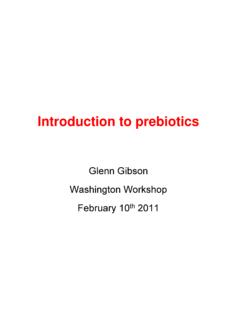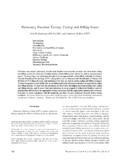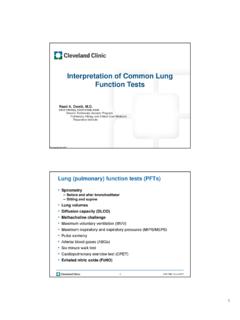Transcription of Nonclinical Safety Evaluation of Inhalation Drug …
1 LSRO, 2/13/021 Nonclinical Safety Evaluation of Inhalation drug ProductsFebruary 13, 2002 Life Science Research OrganizationBethesda, MarylandLuqi Pei, of Pulmonary and Allergy drug ProductsCenter for drug Evaluation and ResearchFood and drug AdministrationLSRO, 2/13/022 DisclaimerInformation presented here represents the speaker s interpretation and opinion of the current rules, regulations and practices at the FDA only. It does not represent the Agency s position on any subjects discussed. LSRO, 2/13/023 Overview Introduction Toxicology Pharmacology Inhalation toxicity studiesLSRO, 2/13/024 Introduction toInhalation drug ProductsInhalation drug Products: Inhalation : an increasingly popular route of drug delivery Indicated for: Diseases of the respiratory system Other systems ( insulin for diabetes) Using devices: metered-dose inhalers, dry powder inhalers, and nebulizers Safety Evaluation consists of.
2 Clinical Nonclinical Manufacturing controlsLSRO, 2/13/025 Scope of Nonclinical Program Toxicology General toxicity Genetic toxicity Carcinogenicity Reproduction and developmental toxicity Special toxicity Toxicokinetics Pharmacology Pharmacodynamics Safety pharmacology pharmacokinetics Compounds of Interest Active ingredients Excipients Formulation Interaction of mixtures Impurities, degradation products, extracables and leachablesLSRO, 2/13/026 Regulatory Guidelines for the Nonclinical Safety Evaluation of Inhalation drug Products Considerations for Toxicology Studies of Respiratory drug Products.
3 DeGoergeet al., Regul Toxicol Pharmacol,1997;25:189-193 ICH guidelines: - ICH FDA guidelines (ICH guidelines plus documents listed in the following site): - Pharm/ToxLSRO, 2/13/027II. Toxicology1. General Toxicity Studies Guidance (ICH) S3B: Pharmacokinetics: Guidance for Repeat-Dose Tissue Distribution Studies (ICH) S4A: Duration of Chronic Toxicity Testing in Animals (Rodent and Non-rodent Toxicity Testing) Studies: Include at least two species ($1 non-rodent species) Use Inhalation (IH) route of administration or IH + non-IH Expose animals daily Treatment duration is up to Six months in rodents One year in non-rodents Evaluate both local and systemic toxicitiesLSRO, 2/13/0282.
4 Genetic Toxicity Studies Guidance S2A: Specific Aspects of Regulatory Genotoxicity Testing for Pharmaceuticals S2B: Genotoxicity: A standard Battery for Genotoxicity Testing for Pharmaceuticals Program Three tests suffice if they give no signal of concern Bacterial mutagenicity test in vitrochromosomal aberration test in vivochromosomal aberration test More tests may be recommended otherwiseLSRO, 2/13/0293. Carcinogenicity Studies Guidance (ICH): S1A: The Need for Long Tern Rodent Carcinogenicity Testing of Pharmaceuticals S1B: Testing for Carcinogenicity of Pharmaceuticals S1C: Dose Selection for Carcinogenicity Studies of Pharmaceuticals S1C(R): Guidance on Dose Selection for Carcinogenicity Studies of Pharmaceuticals Program Bioassays in 2 species Protocols subjected to FDA s review and approvalLSRO, 2/13/02104.
5 Reproductive & Developmental Toxicity Studies Guidance (ICH) S5A: Detection of Toxicity to Reproduction for Medicinal Products (ICH) S5B: Detection of Toxicity to Reproduction for Medicinal Products: Addendum on toxicity to Male Fertility (FDA): Nonclinical Safety Evaluation of Pediatric drug Products Non- Inhalation route of administration may be acceptable Use Inhalation exposure for juvenile animal studiesLSRO, 2/13/02115. Special Toxicity Studies Tissue irritability/compatibility Respiratory hypersensitivity Immunotoxicity OthersLSRO, 2/13/02126. Toxicokinetics Studies Component (usually) of toxicity studies Monitor plasma levels and AUCs of the drug and its metabolites Evaluate both dose proportionality and temporal effects of exposure Guidelines (ICH)S3A: Toxicokinetics: The Assessment of Systemic Exposure in Toxicity Studies LSRO, 2/13/0213 III.
6 Pharmacology Pharmacodynamics Receptor binding and activation Enzyme inhibition and activation Mechanism of drug action Efficacy studies in vitro In vivo drug interactions Safety pharmacology Pharmacokinetics (ADME)LSRO, 2/13/0214IV. Abbreviated Nonclinical Program Consists of only parts of the above Nonclinical program Is applicable to: New drugs with short-term clinical use Well-known drugs or excipients when: Reformulation New route of administrationLSRO, 2/13/0215V. Inhalation Toxicity Studies Should be in compliance with GLP regulations Have five steps process Protocol development Conducting the study Protocol amendments Drafting study report Auditing and finalizing the reportLSRO, 2/13/0216 Exposure System of Inhalation Toxicity StudiesLSRO, 2/13/0217 Characteristics of Inhalation Toxicity Studies Design Modes of Exposure Nose-only Oral Inhalation Needing controls and treated animals Dosimetry Toxicological Evaluation Systemic toxicity: similar to other studies Local toxicity.
7 More detailed evaluationsLSRO, 2/13/0218 Inhalation Toxicity Studies-Design Have Generally five groups Sham control (air, or saline) Vehicle control Testing Groups Low dose Mid dose High dose Include Both sexes / treatment Use extra animals /dose for TK (rats, mice) LSRO, 2/13/0219 Samples of Inhalation Exposure Chambers in Toxicity StudiesLSRO, 2/13/0220 Dosimetry of Inhalation Toxicity Studies Is a theoretical estimate Varies with mode of exposure, particles size, species and anatomic location (indications) Local drug depositions / concentrations Plasma drug levels Needs stringent quality controlsLSRO, 2/13/0221 Deposition of Nasally Inhaled Aerosol Particle in HumansLSRO, 2/13/0222 Effect of Species and Mode of Exposure on Pulmonary drug DepositionLSRO, 2/13/0223 Exposure AssessmentDose (mg/kg/day) = (C x T x M x F) )WWhere.
8 C = Aerosol drug concentration (mg/L)T = Duration of exposure (min/day)M = Minute volume (L/min)F = Deposition factor W = Body weight (kg)LSRO, 2/13/0224 Endpoints for Toxicological Evaluation Dosimetry Systemic toxicity Local toxicityLSRO, 2/13/0225 Dosimetry Evaluation Characterization of the exposure system Particle size distribution Dosing variations Deposition factor used Dose estimatesLSRO, 2/13/0226 Endpoints for Evaluating Systemic Toxicity Clinical observations Mortality Food and water consumption Body weights and body weight gains Any abnormal signs and behavior Ophthalmology EKG and other evaluations Clinical pathology Hematology Serum chemistry Urinalysis Necropsy Histopathological examinationsLSRO, 2/13/0227 Endpoints for Evaluating Local Toxicity Functional changes Plethysmography Lung mechanics Gas diffusing efficiency Biochemistry changes Morphological changes Non-neoplastic changes Neoplastic changesLSRO.
9 2/13/0228 SummaryThe Nonclinical Safety Evaluation of Inhalation drug products: Is a part of the overall Safety Evaluation that: Also includes clinical and CMC disciplines Incorporates risk/benefit analysis Consists of toxicology, pharmacology, and pharmacokinetics Includes the Evaluation of the formulation and its components Needs Inhalation toxicity studies that Examine local and systemic toxicities of the drug Tend to have large variations in their dose estimates Have body burden estimates based on indications Varies with drugs and their indications in Nonclinical requirements LSRO, 2/13/0229 Clinical Considerations for Inhalation Toxicities Short-term considerations (tolerability)
10 Done immediately post-first exposure(s): Tolerability in Normals first Testing in vulnerable populations ( , asthmatics) Assessed by AEs, Serial Spirometry (+/-oximetry) Applies for new drug substance and/or novel excipientLSRO, 2/13/0230 Clinical Considerations for Inhalation Toxicities Long-term considerations (pulmonary Safety ) Work-up / testing level and duration partly depends on pre-clinical toxicology work/expectations Complete work-up could include: Full Pulmonary Function Testing (including lung volumes, diffusion capacity, +/- Pulmonary Exercise Testing, +/- methacholine challenge) Radiography (most sensitive assessment is with high-resolution CT scanning) Pulmonary Adverse Events, examination.



